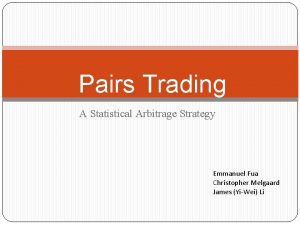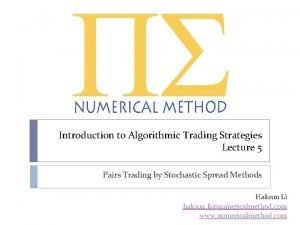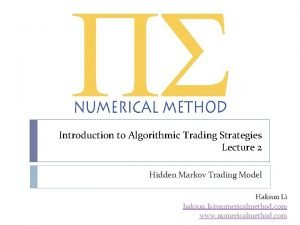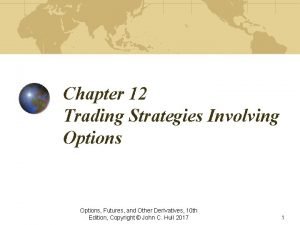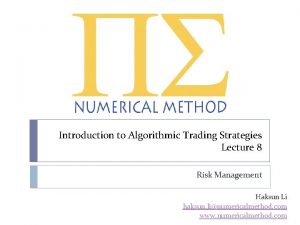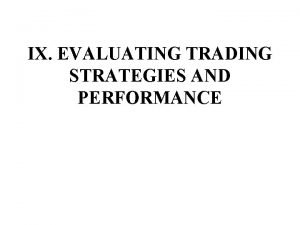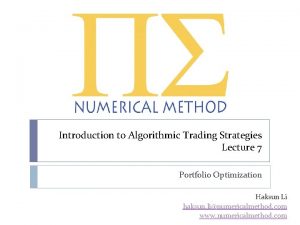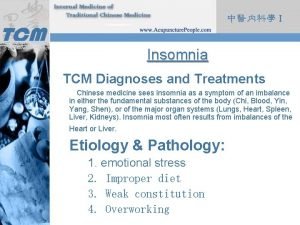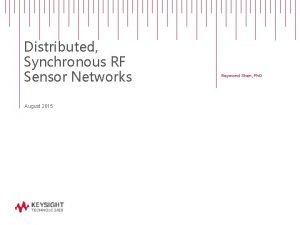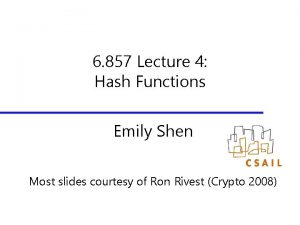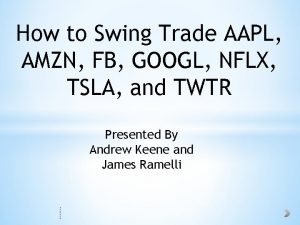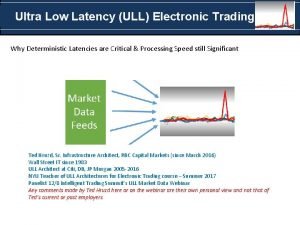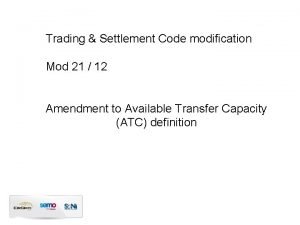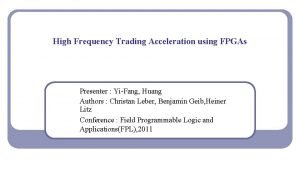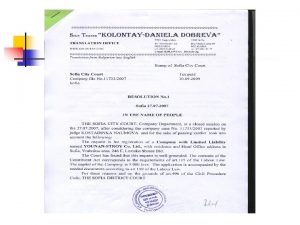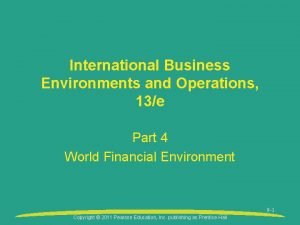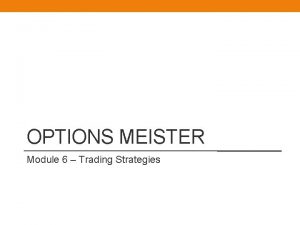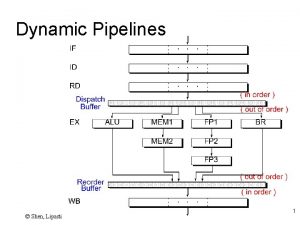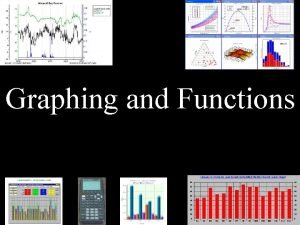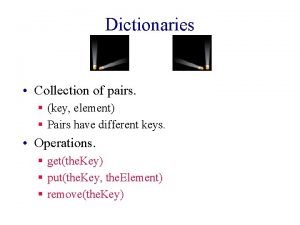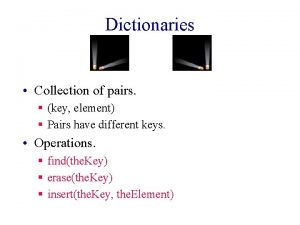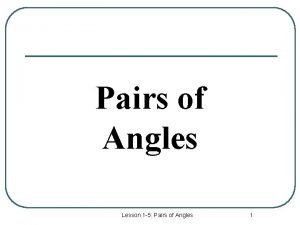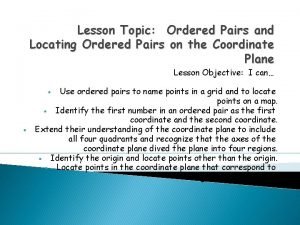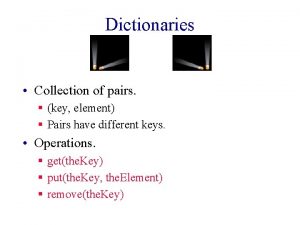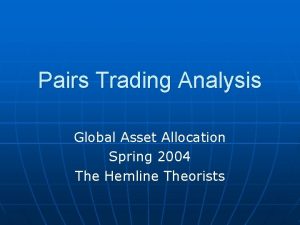Implementation of Pairs Trading Strategies Aldwin Shen Weishun




















































- Slides: 52

Implementation of Pairs Trading Strategies Aldwin Shen Weishun Han Xue Maurice Tjie Zeng Fanchao Nanyang MFE FE 8827: Quantitative Trading Strategies April 2011

CONTENT 1. Introduction 2. Search Process & Criteria 3. Trading Strategies 4. Results & Analysis 5. Conclusion 6. Reference

1. INTRODUCTION Executive Summary • Search for profitable pairs for the implementation of pair-trading strategies using the method of cointegration • Establish a search process and search criteria • Explore various pair-trading strategies • Analyze results on various trading instruments, i. e. Stocks, ETF, Stock Indices

1. INTRODUCTION Pair-Trading • Long one asset against short another (buy the cheap one and sell the expensive one) • Mean-Reversion Strategy: Spread between two highly correlated assets tends to mean revert • Stock-Picking Strategy: Eliminates systematic market risk and capitalize on mispricing in stocks • This report focus on the mean-reversion strategy

1. INTRODUCTION Stationarity & Cointegration • Construct a mean-reverting spread through linear combination • Cointegrating factor (the hedge ratio) is determined by the Johansen method • Spread is checked to be stationary using the Augmented-Dicky-Fuller test

1. INTRODUCTION Trading Instruments • Equity: 50 US stocks from different sectors: Technology, Industrials, Energy, Consumer Staples, Finances, Material, Healthcare • ETF: 13 ETFs replicating index in various countries: Dow Jones, Midcap Value, Midcap Growth, Brazil, Germany, UK, Australia. • Indices: 10 Major Indexes: DJIA, Nasdaq, S&P, DAX, CAC, STI, HSI, Nikkei, etc

2. SEARCH PROCESS & CRITERIA Search Process • Search process is run between individual asset in each instrument class via a MATLAB script • Search process is initiated with 40 days of historical data recursively from 31 st Dec 2009 • If statistical test for mean reversion is significant (taking 95% confidence level), the spread is extended with 20 days • The iteration is repeated until there is no significant evidence for mean reversion

2. SEARCH PROCESS & CRITERIA Pair-Trade Criteria Factors suggesting suitable trading pairs include: • Length: Longest period showing significant evidence of mean reversion • t-statistic: More negative t-statistic signifying a more statistically significant evidence of mean reversion

3. TRADING STRATEGIES Back-testing Procedure • Trading pairs are determined from the search procedure using historical data recursively from 31 st Dec 2009 • Identified trading pairs are back-tested using historical data from 1 st Jan 2010 to 31 st Dec 2010 to determine the cumulative profit • 3 different trading strategies are employed on the 3 different classes of trading instruments

3. TRADING STRATEGIES Trading Strategy I • Using calibrated hedge ratio & mean to trade without recalibration or rebalancing • Strategy - Buy when z < mean + 0. 5 * sigma - Sell when z > mean + 0. 5 * sigma • Intuition: Assumes mean reversion about the historical long-term mean exist

3. TRADING STRATEGIES Trading Strategy II • Adopts a dynamic calibration of hedge ratio & mean for a window of every 10 trading days and used to trade for the next 10 trading days with rebalancing • Strategy - Buy when z < mean + 0. 5 * sigma - Sell when z > mean + 0. 5 * sigma • Intuition: Assumes mean reversion about a mean with stochastic drift exist

3. TRADING STRATEGIES Trading Strategy III • Using calibrated hedge ratio to trade without recalibration or rebalancing • Strategy - Buy when zt < zt-1 + 0. 5 * sigma - Sell when zt > zt-1 + 0. 5 * sigma • Intuition: Assumes that mean reversion follows immediately after a price shock

4. RESULTS – Search for Cointegrated Pairs • Results on the search of cointegrated pairs for Equity Top 10 Equity Pairs based on Length

4. RESULTS – Search for Cointegrated Pairs • Results on the search of cointegrated pairs for ETF and Indices Top 5 ETF Pairs based on T-Statistics Top 5 Indices Pairs based on T-Statistics

4. RESULTS & ANALYSIS - EQUITY Trading Strategy I • GR Vs F P&L: -2. 44

4. RESULTS & ANALYSIS - EQUITY Trading Strategy I • AMZN Vs NYX P&L: 12. 63

4. RESULTS & ANALYSIS - EQUITY Trading Strategy I • CVX Vs LM P&L: 9. 63

4. RESULTS & ANALYSIS - EQUITY Trading Strategy I: Analysis • Spread is not mean reverting around the historical long-term mean. • A trading position is entered into and the position is held for prolonged period as there is no exit signal. • Not a feasible trading strategy.

4. RESULTS & ANALYSIS - EQUITY Trading Strategy II • GR Vs F P&L: 20. 57

4. RESULTS & ANALYSIS - EQUITY Trading Strategy II • AMZN Vs NYX P&L: 56. 80

4. RESULTS & ANALYSIS - EQUITY Trading Strategy II • CVX Vs LM P&L: 5. 31

4. RESULTS & ANALYSIS - EQUITY Trading Strategy II: Analysis • Shows a higher trading activity compared to Strategy I and is consistently profitable for the pairs analyzed. • Apparently the most appropriate pair-trading strategy for Equity.

4. RESULTS & ANALYSIS - EQUITY Trading Strategy III • GR Vs F P&L: 44. 10

4. RESULTS & ANALYSIS - EQUITY Trading Strategy III • AMZN Vs NYX P&L: -40. 89

4. RESULTS & ANALYSIS - EQUITY Trading Strategy III • CVX Vs LM P&L: 0. 58

4. RESULTS & ANALYSIS - EQUITY Trading Strategy III: Analysis • Displays inconsistent performance across the pairs analyzed. There is a possibility of huge profits as well as huge losses. • This implies that there is no specific reaction to price shocks for equity pair-trading.

4. RESULTS & ANALYSIS - ETF Trading Strategy I • MSCI Pac Ex-Jap Vs MSCI UK P&L: -1. 06

4. RESULTS & ANALYSIS - ETF Trading Strategy I • i. Shares Aust Index Vs MSCI UK P&L: 6. 55

4. RESULTS & ANALYSIS - ETF Trading Strategy I: Analysis • Spread is not mean reverting around the historical long-term mean. • A trading position is entered into and the position is held for prolonged period with few exit signals. • Trading activity is more as compared to Equity. • Not a feasible trading strategy.

4. RESULTS & ANALYSIS - ETF Trading Strategy II • MSCI Pac Ex-Jap Vs MSCI UK P&L: 15. 82

4. RESULTS & ANALYSIS - ETF Trading Strategy II • i. Shares Aust Index Vs MSCI UK P&L: 9. 70

4. RESULTS & ANALYSIS - ETF Trading Strategy II: Analysis • Shows a higher trading activity compared to Strategy I and is consistently profitable for the pairs analyzed. • It is an appropriate strategy for ETF.

4. RESULTS & ANALYSIS - ETF Trading Strategy III • MSCI Pac Ex-Jap Vs MSCI UK P&L: 20. 76

4. RESULTS & ANALYSIS - ETF Trading Strategy III • i. Shares Aust Index Vs MSCI UK P&L: 10. 61

4. RESULTS & ANALYSIS - ETF Trading Strategy III: Analysis • Shows a higher trading activity compared to Strategy I and is consistently profitable for the pairs analyzed. • It is an appropriate strategy for ETF. • This implies that ETF pair trades mean-revert closely after price shocks.

4. RESULTS & ANALYSIS - INDICES Trading Strategy I • DJIA Vs NIKKEI 225 P&L: 2948. 51

4. RESULTS & ANALYSIS - INDICES Trading Strategy I • FTSE 100 Vs NIKKEI 225 P&L: 425. 30

4. RESULTS & ANALYSIS - INDICES Trading Strategy I • CAC 40 Vs NIKKEI 225 P&L: 425. 30

4. RESULTS & ANALYSIS - INDICES Trading Strategy I: Analysis • Spread is not mean reverting around the historical long-term mean. • A trading position is entered into and the position is held for prolonged period with few exit signals. • Not a feasible trading strategy.

4. RESULTS & ANALYSIS - INDICES Trading Strategy II • DJIA Vs NIKKEI 225 P&L: 2002. 62

4. RESULTS & ANALYSIS - INDICES Trading Strategy II • FTSE 100 Vs NIKKEI 225 P&L: 1153. 89

4. RESULTS & ANALYSIS - INDICES Trading Strategy II • CAC 40 Vs NIKKEI 225 P&L: 813. 38

4. RESULTS & ANALYSIS - INDICES Trading Strategy II: Analysis • Shows a higher trading activity compared to Strategy I and is consistently profitable for the pairs analyzed. • Profits analyzed may not be accurate as the pairs are analyzed based on the spot indices and not index futures and tick value is not accounted for. However, it gives a clear indication of relative performance amongst the trading strategies. • It is an appropriate strategy for Indices.

4. RESULTS & ANALYSIS - INDICES Trading Strategy III • DJIA Vs NIKKEI 225 P&L: 6471. 68

4. RESULTS & ANALYSIS - INDICES Trading Strategy III • FTSE 100 Vs NIKKEI 225 P&L: 2044. 30

4. RESULTS & ANALYSIS - INDICES Trading Strategy III • CAC 40 Vs NIKKEI 225 P&L: 2108. 45

4. RESULTS & ANALYSIS - INDICES Trading Strategy III: Analysis • Shows a higher trading activity compared to Strategy I and is consistently profitable for the pairs analyzed. • Apparently this is the most profitable strategy for indices. • This implies that Indices pair trades mean-revert closely after price shocks.

5. CONCLUSION • The pair trading search process is most easily applicable to Equity as there are more individual assets to compare and easier to arrive at profitable pairs. • Using the length and t-statistic of mean reversion from the search procedure is a useful indication of profitable pairs for trading. • Pair trading performance for ETF and Indices are more consistent as compared to that of Equity.

5. CONCLUSION • Trading Strategy I is not an appropriate trading strategy for the classes of trading instruments analyzed as there exists a stochastic drift away from the historical long-term mean. • Trading Strategy II is the most appropriate trading strategy for Equity. • Trading Strategy II & III are equally appropriate for ETF pair trading. • Trading Strategy III is the most profitable trading strategy for Indices however Trading Strategy is appropriate as well.

6. REFERENCE • Øyvind Foshaug. Implementation of Pairs Trading Strategies. Faculty of Science. Koortweg- de Vries Institute for Mathematics. Master of Science Thesis. 2010. • Ernest Chan. Quantitative Trading: How to Build Your Own Algorithmic Trading Business. • Haksun Li. Lecture Materials “Quantitative Trading Strategies” course in M. Sc Financial Engineering, NTU. 2011

7. APPENDICES – README FILE • Guide to run the Pair Trading Program is available in README. txt in the “Pairs Trading” directory. • Alternatively, 1. Open Directory : "Pairs Trading" with MATLAB 2. Run GUI. m 3. Type the ticker for Asset 1 and Asset 2 - Both Asset 1 and Asset 2 must be from the same Asset classes - The ticker code can be found in the next slide 4. Choose the corresponding Asset Class for the two tickers from the drop down menu 5. Choose Strategy that we want to backtest 6. Wait for several minutes for the backtesting to complete 7. Three graphs will pop-up and Final P&L is shown in lower left corner of the window 1. Position 2. Price 3. Profit 8. Close the Window before running another backtesting 9. To run a new backtesting with different strategy/ticker, repeat step 2

7. APPENDICES – README FILE
 Accounting for non trading organisation
Accounting for non trading organisation Pairs trading cointegration
Pairs trading cointegration Trigonal pyramidal with lone pair
Trigonal pyramidal with lone pair Kalman filter trading strategy
Kalman filter trading strategy Introduction to algorithmic trading strategies
Introduction to algorithmic trading strategies Market microstructure trading strategies
Market microstructure trading strategies Trading strategies involving options
Trading strategies involving options Introduction to algorithmic trading strategies
Introduction to algorithmic trading strategies Evaluating trading strategies
Evaluating trading strategies Introduction to algorithmic trading strategies
Introduction to algorithmic trading strategies Implementation of strategies
Implementation of strategies Wu tou tang
Wu tou tang Xipeng shen
Xipeng shen Verse dao
Verse dao Qun shen
Qun shen Shen
Shen Liu shen & associates
Liu shen & associates Chien-chung shen
Chien-chung shen Las 7 emociones medicina china
Las 7 emociones medicina china Fu shen massage
Fu shen massage River shen
River shen Raymond shen
Raymond shen Zhiming shen
Zhiming shen Ni jiao shen me
Ni jiao shen me Shen, wei-min
Shen, wei-min Michael m. shen
Michael m. shen Shen lisp
Shen lisp Tengming shen
Tengming shen Max shen
Max shen Indeterminate error
Indeterminate error Haiying shen
Haiying shen Emily shen md
Emily shen md Sammy flood naked
Sammy flood naked Suwit trading company ltd
Suwit trading company ltd Alan michael sugar
Alan michael sugar Trading comparables
Trading comparables Trading de alta frecuencia
Trading de alta frecuencia Exchanges over trillion trading volume this
Exchanges over trillion trading volume this Primark ethical trading
Primark ethical trading Fbgoogl
Fbgoogl Option premium
Option premium Mortgage hedging 101
Mortgage hedging 101 What is futures trading
What is futures trading Ull trading network
Ull trading network Napoleon trading bot
Napoleon trading bot Trading and settlement code
Trading and settlement code Retail location and site selection ppt
Retail location and site selection ppt Mithras trading fze
Mithras trading fze Fpga high frequency trading
Fpga high frequency trading Kreto investment
Kreto investment Sundry expenses
Sundry expenses Forex trading process
Forex trading process Reckless trading
Reckless trading

